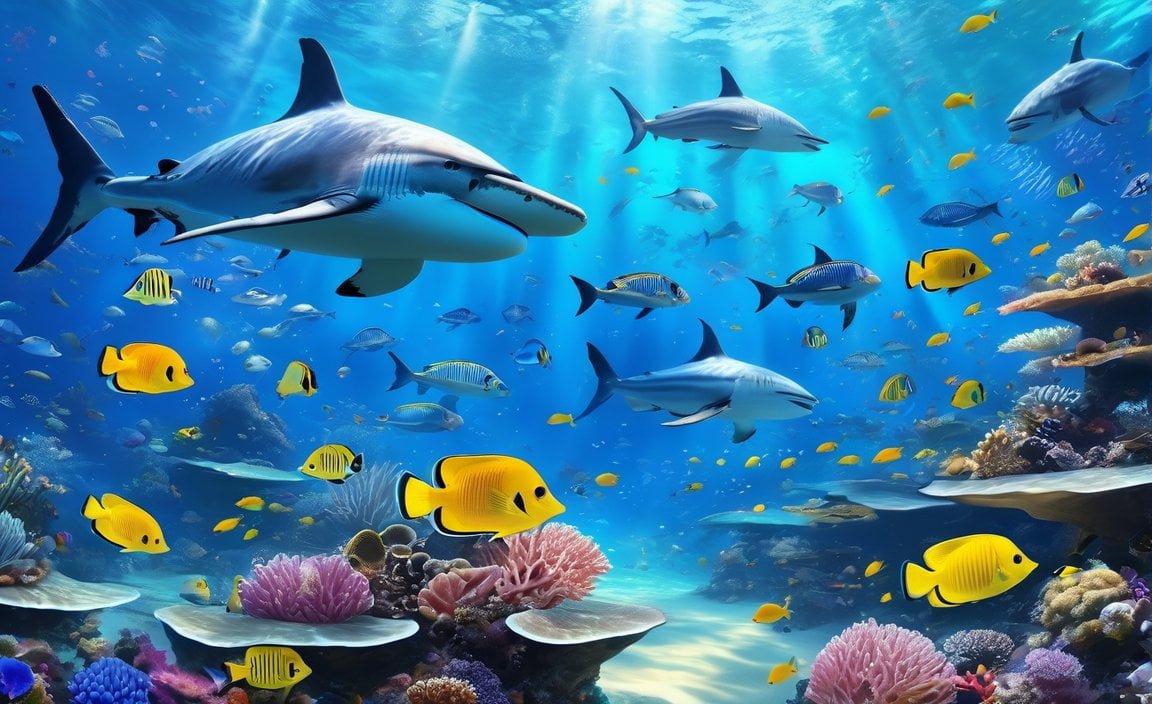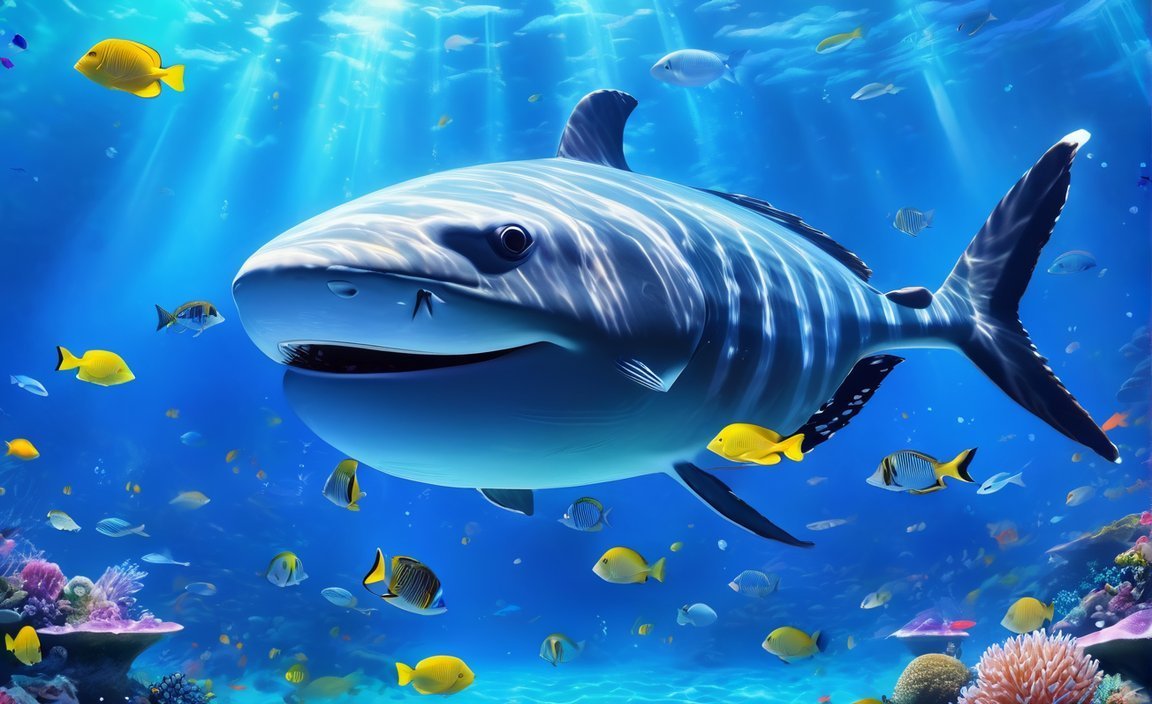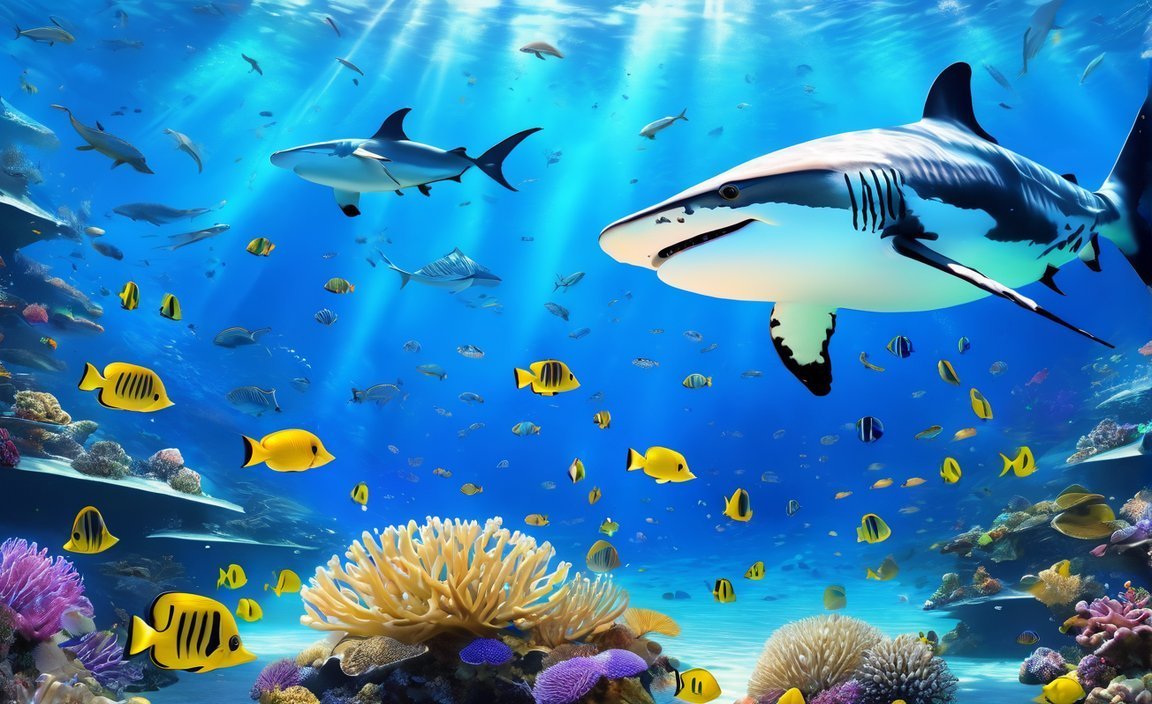Exploring the Depths: 10 Intriguing Marine Life Facts unveils a captivating journey into the lesser-known aspects of the underwater world. As we delve into the mysterious depths of our oceans, marvel at the intricate relationships between marine organisms and their surroundings. From hidden adaptations to awe-inspiring behaviors, this article aims to share an array of fascinating facts that will leave you in awe of the incredible biodiversity within our oceans. Prepare to be amazed by these captivating insights into the wonders of marine life.

Key Takeaways:
- The speed of sound in water is nearly five times faster than in air, measuring at 1,435 m/sec.
- The oceans cover 99% of the living space on Earth and support 50-80% of all life.
- Jellyfish have existed for over 650 million years, predating dinosaurs and sharks.
- Electric Eels can generate enough electricity to power up to 10 electric bulbs.
- Dolphins sleep with only half their brain and one eye open to stay alert for predators.
- The Great Barrier Reef is the largest living structure on Earth.
- The blue whale, weighing around 200 tons, is the largest animal on the planet.
- The Mariana Trench is the deepest part of the ocean, reaching a depth of 36,070 feet.
- The sperm whale is the world’s largest predator.
- The Serengeti hosts the world’s largest animal migration, with over 1 million wildebeest on the move each year.
For more information on marine life, refer to the sources provided by Seashore Realty and All That’s Interesting.
10 Facts About Marine Life
The Speed of Sound:
Did you know that sound travels much faster in water than in air? In fact, the speed of sound in water is approximately 1,435 meters per second, which is nearly five times faster than in the air[^1^]. This incredible speed allows marine animals to communicate across vast distances and navigate their underwater world with ease.The Vastness of the Oceans:
Our planet’s oceans provide an astonishing 99% of the living space on Earth[^1^]. These vast bodies of water harbor an incredible range of marine life, containing between 50 and 80% of all species known to science[^1^]. From the tiniest plankton to the majestic whales, the oceans teem with biodiversity.Ancient Jellyfish:
Jellyfish have an ancient lineage, with their existence dating back more than 650 million years[^1^]. This means that jellyfish have outlived both dinosaurs and even sharks. These mesmerizing creatures have adapted to survive in various marine environments, making them an integral part of the ocean’s delicate ecosystem.The Electric Power of Eels:
Electric eels possess an extraordinary ability to generate electricity. In fact, a single electric eel is capable of producing shocks strong enough to power up to 10 electric light bulbs[^1^]. This unique adaptation helps them navigate their environment, find food, and defend themselves from potential predators.Dolphin’s Special Sleep Pattern:
Dolphins have an intriguing way of getting their beauty sleep. They sleep with only half of their brain at a time and keep one eye open to remain vigilant for predators or other threats[^1^]. This allows them to rest while ensuring their safety in the vast ocean.The Magnificent Great Barrier Reef:
The Great Barrier Reef, located off the coast of Australia, is the largest living structure on our planet[^1^]. Stretching over 2,300 kilometers, it is home to a staggering variety of marine life, including colorful corals, fish, turtles, and countless other fascinating creatures.The Mighty Blue Whale:
The blue whale holds the title for being the largest animal to have ever lived on Earth. These majestic creatures can weigh as much as 200 tons, which is equivalent to about 33 adult elephants[^1^]. Their sheer size is awe-inspiring and a testament to the wonders of marine life.The Depths of the Mariana Trench:
The Mariana Trench, located in the western Pacific Ocean, is the deepest part of the ocean. Plunging to a depth of approximately 36,070 feet, it is an otherworldly environment that only a few explorers have had the privilege to witness[^1^]. Its depths remain a mystery, with the potential for new discoveries still awaiting us.The Mighty Sperm Whale:
The ocean is home to some remarkable predators, and the sperm whale claims the title for being the largest among them[^1^]. These incredible creatures can grow up to 60 feet in length and weigh around 45 tons. Their powerful presence and hunting abilities make them a fascinating species to study.The Epic Animal Migration:
The world’s largest animal migration takes place in the ocean[^1^]. Each year, over 1 million wildebeest brave dangerous waters and embark on an incredible journey across the Serengeti. This migration showcases the resilience and determination of marine life, highlighting their remarkable adaptability.
These ten fascinating facts about marine life provide a glimpse into the wonders of our oceans and the incredible diversity that resides beneath the surface. From the astonishing speed of sound in water to the ancient existence of jellyfish, there is always something new and captivating to learn about the underwater world.
For more information on marine life and its awe-inspiring facts, you can explore the following sources:
1. Seashore Realty: 15 Interesting Marine Life Facts
2. All That’s Interesting: Amazing Facts About Ocean Animals
Let these discoveries ignite your curiosity and foster a deeper appreciation for the extraordinary marine life that inhabits our oceans.
Here are some interesting facts that you should know about biomes: 10 facts about biomes
Did you know that condensation plays a crucial role in our weather? Check out these fascinating facts about condensation: 10 facts about condensation
Explore the wonders of marine biology with these incredible facts: 10 facts about marine biology
Dive into the captivating world of marine life and discover some amazing facts: 10 facts about marine life
Discover fascinating facts about ocean life and its astounding creatures: 10 facts about ocean life
Learn all about temperate deciduous forests and their unique characteristics with these interesting facts: 10 facts about temperate deciduous forest
Delve into the enchanting world of temperate forests and uncover some intriguing facts: 10 facts about temperate forests
Immerse yourself in the beauty of temperate rainforests with these captivating facts: 10 facts about temperate rainforest
Embark on an adventure through the African savanna and discover some incredible facts: 10 facts about the African savanna
Take a deep dive into the mysterious world of ocean animals with these fascinating facts: 10 facts about the ocean animals
Journey to the enchanting tropical savanna and learn some interesting facts about this unique ecosystem: 10 facts about the tropical savanna
Some marine animals, like the humpback whale, engage in long-distance migrations covering thousands of kilometers each year.
The marine world is full of fascinating creatures, and among them, the humpback whale stands out for its incredible migration capabilities. These majestic creatures travel vast distances each year, covering thousands of kilometers in search of mating and calving grounds. Let’s dive deeper into this astonishing behavior and explore some interesting facts about the long-distance migrations of marine animals like the humpback whale.
The Fascinating Migrations of Humpback Whales
Humpback whales, known for their distinctive songs and displays, are baleen whales that can reach lengths of 12 to 16 meters and weigh up to 36 metric tons. With their black upper surface and varying amounts of white below, they are a sight to behold. These magnificent creatures can be found in all the world’s major oceans, and their migratory journeys are nothing short of awe-inspiring.
The Longest Migrations of any Mammal
Humpback whales undertake some of the longest migrations of any mammal. They swim up to 5,000 miles between their breeding and feeding grounds every year. Imagine covering a distance equivalent to traveling from New York City to Los Angeles, not once, but multiple times in a year! These long-distance journeys are vital for the survival of humpback whales and the continuation of their species.
A Test of Strength and Endurance
During their migrations, humpback whales rely on their stored energy reserves, known as blubber, to fuel their journey. This blubber provides them with the necessary energy to undertake these grueling journeys and fulfill their breeding purposes. The ability of these whales to navigate such vast distances showcases their strength, endurance, and remarkable adaptability to their marine environment.
Sticking to Tradition
Despite changes in ocean conditions caused by climate change, humpback whales stick to their traditional migration routes. This steadfast adherence to established pathways is remarkable, considering the challenges posed by shifting ocean currents, temperature variations, and other environmental factors. Their ability to maintain these time-honored routes speaks volumes about their navigational instincts and the adaptations that have been developed over generations.
Preservation Challenges and a Call for Conservation
Like many marine species, humpback whales face significant threats, including entanglement in fishing gear. These entanglements can lead to fatigue, compromised feeding ability, and severe injuries, putting their long journeys at risk. It is essential to raise awareness about the conservation of these magnificent creatures and promote responsible fishing practices to ensure their continued survival.
Key Takeaways:
– Humpback whales undertake extensive migrations, covering thousands of kilometers each year in search of mating and calving grounds.
– These migrations are some of the longest of any mammal, with humpback whales swimming up to 5,000 miles between breeding and feeding areas.
– Humpback whales rely on their stored energy reserves, called blubber, to fuel their long journeys.
– Despite changing ocean conditions due to climate change, humpback whales maintain their traditional migration routes.
– Conservation efforts and responsible fishing practices are crucial to protect humpback whales and ensure the preservation of their migratory behaviors.
Sources:
– Encyclopedia Britannica: Link
– NOAA Fisheries: Link
Marine Bioluminescence: The Enchanting Glow of Underwater Life
Marine bioluminescence is a fascinating phenomenon where organisms produce light, often used for communication or luring prey. From the depths of the ocean to its very surface, this captivating display of natural illumination has intrigued scientists and enchanted marine enthusiasts for centuries. Let’s delve into this mesmerizing world and uncover ten intriguing facts about this remarkable marine phenomenon.
Key Takeaways:
- Marine bioluminescence is the production of light within the bodies of marine organisms through a chemical reaction.
- The mesmerizing light is emitted when a pigment called luciferin reacts with oxygen in the presence of an enzyme called luciferase.
- Bioluminescence serves vital functions in marine ecosystems, including attracting mates, finding food, and communicating with others.
- Marine creatures rely on bioluminescence for survival in different ways, such as luring prey, camouflaging themselves, and warding off potential predators.
- Bioluminescence has evolved independently multiple times in marine organisms, highlighting its significant role in ecological interactions and evolutionary processes.
Now, let’s embark on an enchanting journey of discovery as we explore ten fascinating and lesser-known facts about marine bioluminescence.
1. The Dazzling Diversity of Bioluminescent Organisms
The underwater world is teeming with an astonishing array of bioluminescent organisms. From tiny single-celled organisms, such as dinoflagellates, to larger creatures like deep-sea anglerfish and firefly squids, a remarkable variety of marine life displays this captivating natural light show.
2. The Deep-sea Delights: Bioluminescence in the Abyss
Deep-sea environments, where sunlight barely penetrates, harbor some of the most spectacular displays of bioluminescence. The darkness is illuminated by glowing organisms, creating a mesmerizing scene that is both beautiful and eerie. These organisms have refined their bioluminescent abilities to survive in the pitch-black deep-sea habitats.
3. The Magic of Agitated Waters: Sparkling Bioluminescence
Have you ever witnessed the phenomenon of sparkling waves at night? The sparkling effect is caused by bioluminescent dinoflagellates – single-celled organisms that emit light when disturbed by movement. Swirling in the water, these dinoflagellates create a luminous spectacle that transforms ordinary waves into a bewitching display of glowing blue.
4. The “Mating Dance” of Bioluminescent Organisms
For many marine creatures, bioluminescence plays a vital role in courtship and mating rituals. In the darkness of the ocean, glowing displays guide potential mates towards each other. From the graceful movements of glowing jellyfish to the dazzling light shows of firefly squid, bioluminescence sets the stage for underwater romances.
5. The Art of Camouflage: Bioluminescence as a Survival Strategy
Some marine organisms have harnessed the power of bioluminescence to blend seamlessly with their surroundings. By emitting light that matches the intensity and color of their environment, these organisms create a cloaking effect, rendering themselves virtually invisible to predators or prey. It’s Mother Nature’s way of saying, “Now you see me, now you don’t!”
6. The Red Light District of the Ocean
Did you know that red light is absorbed more quickly in water than other colors? This unique property makes red bioluminescence particularly useful for deep-sea organisms as it allows them to communicate without drawing unwanted attention from predators. In this mysterious realm, the ocean whispers secrets in a language of glowing crimson.
7. The Illuminating Illusions of Counterillumination
Imagine swimming in the moonlit ocean, only to suddenly find yourself looking at a perfectly mirrored reflection of the sky above you. This mesmerizing effect, known as counterillumination, is created by organisms like lanternfish. By emitting light from their transparent bellies, they counter the silhouette they would create if seen from below, effectively blending into the starlit night.
8. The Gentle Glow of the Twilight Zone
The twilight zone, a region between the sunlit surface and the pitch-black depths of the ocean, is an enchanting realm where bioluminescence reigns. Glowing organisms fill this transitional space, creating a soft and ethereal glow that adds an otherworldly dimension to the mystique of the deep-sea.
9. The Chemical Symphony of Bioluminescence
The chemical mechanisms responsible for bioluminescence are as diverse as the organisms that possess this extraordinary ability. Different species utilize a variety of chemicals, ranging from luciferin and luciferase to other light-producing compounds. This intricate symphony of biochemical reactions contributes to the mesmerizing light displays that grace our oceans.
10. The Illuminating Future: Unlocking the Secrets of Marine Bioluminescence
The study of marine bioluminescence uncovers new wonders and sheds light on the intricate relationships between organisms and their environment. Researchers continue to explore the mysteries of this captivating phenomenon, seeking to understand its function in ecological interactions, its evolutionary significance, and its potential applications in various fields, including medicine and technology.
As we peer into the enigmatic depths of the ocean, we uncover the mesmerizing world of marine bioluminescence. It is a phenomenon that captivates our imagination, reminding us of the thrilling diversity and awe-inspiring beauty that lies beneath the surface of our planet’s vast waters. Next time you dip your toes in the ocean, remember that the real magic is not just in the glittering waves above but in the breathtaking symphony of light that unfolds beneath the waves.
Sources:
– Britannica
– Smithsonian Ocean
– Annual Reviews
– PLOS
– Science | AAAS
– National Geographic
– NOAA Ocean Exploration
Despite their beauty, coral reefs are highly sensitive ecosystems that are threatened by climate change and human activities.
Coral reefs, magnificent and awe-inspiring, are not just a sight to behold but also delicate ecosystems that are facing numerous threats. These intricate marine habitats face significant challenges due to two main factors: climate change and human activities. Let’s take a closer look at the vulnerabilities of coral reefs and the actions needed to protect them.
The Impact of Climate Change on Coral Reefs
Coral Bleaching and Rising Sea Surface Temperatures: Coral reefs are highly sensitive to climate change, with coral bleaching being a clear indicator of the negative effects. When sea surface temperatures rise due to global warming, coral polyps expel the colorful algae living in their tissues. As a result, the corals turn pale or white, leaving them weakened and vulnerable to disease and death.
Reduced Biodiversity: As climate change disrupts the delicate balance of marine ecosystems, coral reefs experience a loss of biodiversity. As the temperature rises, certain coral species struggle to survive, impacting the overall diversity and functionality of the reef ecosystem.
Resilience and Vulnerability: While some corals have shown resilience to the effects of climate change, the overall vulnerability of coral reefs remains a cause for concern. The long-term impact of rising temperatures and other climate-related stressors might outweigh the resilience capacity of these remarkable ecosystems.
Human Activities Threatening Coral Reefs
Unsustainable Fishing Practices: Unsustainable fishing practices, such as overfishing and destructive fishing methods, directly impact coral reef ecosystems. Damaging fishing gear and practices can harm coral structures and disturb the delicate balance of the reef, leading to long-lasting negative consequences.
Land-Based Pollution: Pollution from land-based activities, including runoff from agricultural practices and coastal development, contributes to the deterioration of coral reefs. Chemicals, sediments, and excess nutrients make their way into the ocean, leading to poor water quality and harming coral health.
Tropical Storms: Climate change has been linked to an increase in the frequency and intensity of tropical storms. These storms can wreak havoc on coral reefs, causing physical damage and disrupting the stability of the ecosystem.
Disease Outbreaks: Coral diseases have become more prevalent in recent years, and their impact on coral reefs cannot be underestimated. The combination of stressors from climate change and pollutants weakens corals, making them more susceptible to disease outbreaks.
The Importance of Coral Reefs and the Way Forward
Coral reefs provide essential services to both the environment and human populations. They support a vast array of marine life, from tiny organisms to larger species, and protect coastlines from erosion. Additionally, coral reefs offer livelihoods and food security to millions of people, mostly in impoverished countries.
To protect and preserve these sensitive ecosystems, there is a need for urgent action:
Mitigating Climate Change: Reducing greenhouse gas emissions is critical to combatting the destructive effects of climate change on coral reefs. Transitioning to cleaner and more sustainable energy sources is an important step in this direction.
Implementing Sustainable Fishing Practices: Enforcing regulations and adopting sustainable fishing practices can help reduce the pressure on coral reefs. Protecting key marine habitats and establishing marine protected areas can also ensure the long-term viability of fish populations and protect the reef ecosystem.
Reducing Pollution: Addressing land-based pollution by implementing proper waste management strategies, including erosion control and agricultural best practices, is vital. Raising awareness about the impact of pollution on coral reefs is also crucial in encouraging individuals and industries to take responsible actions.
Enhancing Conservation Efforts: Investing in the conservation and restoration of coral reefs is fundamental for their survival. This includes reef restoration projects, monitoring, and research to better understand these delicate ecosystems.
Key Takeaways:
- Coral reefs are highly sensitive ecosystems threatened by climate change and human activities.
- Coral bleaching caused by rising sea surface temperatures is a significant consequence of climate change.
- Unsustainable fishing, land-based pollution, tropical storms, and disease outbreaks pose threats to coral reefs due to human activities.
- Coral reefs harbor the highest biodiversity of any ecosystem globally and provide food and livelihoods for millions of people.
- Protecting and restoring coral reefs requires action to mitigate climate change, adopt sustainable fishing practices, reduce pollution, and enhance conservation efforts.
Sources:
- National Center for Biotechnology Information. link
- National Oceanic and Atmospheric Administration. link

FAQ
Q1: What is the speed of sound in water compared to air?
A1: The speed of sound in water is nearly five times faster than the speed of sound in air.
Q2: How much of the living space on the planet do the oceans provide?
A2: The oceans provide 99% of the living space on the planet, containing 50-80% of all life.
Q3: How long have jellyfish been around?
A3: Jellyfish have been around for more than 650 million years, outdating both dinosaurs and sharks.
Q4: How much electricity can an Electric Eel produce?
A4: An Electric Eel is known to produce electricity sufficient enough to light up to 10 electric bulbs.
Q5: How do dolphins sleep?
A5: Dolphins sleep with only half of their brain and with one eye open to watch for predators and other threats.
- China II Review: Delicious Food & Speedy Service - April 17, 2025
- Understand Virginia’s Flag: History & Debate - April 17, 2025
- Explore Long Island’s Map: Unique Regions & Insights - April 17, 2025
















